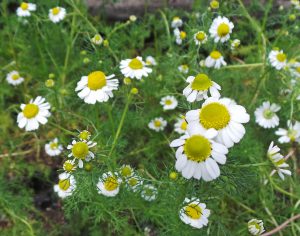Homegrown herbal remediesLabels on store-bought herbs rarely reveal how plants are raised, let alone how long the ingredients are exposed to light and high temperatures while stored in their plastic containers. Grow your own to ensure the best quality and potency of your herbal remedies.
“The primary benefit is being able to develop a relationship with that herb,” according to Jen Bredesen, an herbalist and teacher at the California School of Herbal Studies. Even novice gardeners can concoct simple home remedies such as teas and salves using Bredesen’s list of the top nine easy-to-grow medicinal herbs.
Calendula (Calendula officinalis)

Calendula is also known as pot marigold. It’s a centuries-old antifungal, antiseptic, wound-healing ally. The petals of these cheerful yellow-and-orange daisy-like flowers lend skin-soothing properties to many natural cosmetics and diaper creams.
Calendula is a freely reseeding annual that blooms all season long. It makes a lovely addition to gardens with full sun. Harvest the petals fresh. You can also dry entire blooms — which close in the evening — before they form seeds.
Cilantro (Coriandrum sativum)
Cilantro boasts a unique flavor that people either love or hate. The leaves often garnish Mexican and Thai dishes. The seeds, known as coriander, are a prime ingredient in Indian curries.
Few think of this plant as a medicinal herb, but researchTrusted Source shows it’s a powerful digestive aid and may be capable of removing heavy metals and other toxic agents from the body.
Cilantro grows best in a cool, moist garden and will quickly bolt in hot weather. Look for slow bolt varieties from seed companies. Try this recipe for cleansing cilantro pesto.
Lemon balm (Melissa officinalis)
The oils, tannins, and bitters in the fragrant leaves and flowers of lemon balm have a relaxing, antispasmodic effect on the stomach and nervous system. It may help fight off viruses such as herpes simplex when used topically, according to a 2008 study.
Lemon balm is tasty and gentle enough for children when prepared in teas or tinctures with a glycerin base.
This calming and uplifting perennial makes a pretty patch of bright green in the garden and is a great plant to grow fresh. The dried herb loses some potency after six months. Try this lemon balm and peppermint infusion.
Peppermint (Mentha x piperita)
Spearmint and peppermint are familiar flavors in toothpaste and chewing gum. Both pack a powerfully refreshing zing, but the National Center for Complementary and Integrative HealthTrusted Source (NCCIH) reports that peppermint provides stronger medicine than its more culinary cousin.
When brewed as tea, peppermint may relieve digestive discomforts such as indigestion and vomiting. It can also soothe sore muscles when applied topically as a liquid or lotion.
All mints spread rampantly in a moist garden. Consider growing each plant in its own large pot. Harvest leaves just before flowering. Any longer, and they’ll begin to taste bitter.
Rosemary (Rosmarinus officinalis)
Rosemary is the great reviver. This perennial woody herb stimulates energy and optimism and sharpens memory and concentration by bringing more oxygen to your brain. It’s a wonderfully stimulating alternative to caffeine when you need that second wind.
A row of these long-lived and drought-tolerant plants makes a beautiful, bee-friendly evergreen hedge. You may only need one plant in your garden — a little goes a long way.
Mulle (Verbascum thapsus)in
Mullein’s soothing properties may help heal bronchial respiratory infections. The leaves are commonly added to cough formulas.
Give this handsome and stately biennial plenty of space, and stand back in wonder. The sturdy, yellow-flowered stem will emerge from within a rosette of thick, hairy leaves, reaching skyward nearly 6 feet.
Thyme (Thymus vulgaris)
This groundcover’s delicate stems and tiny leaves belie the tremendous power attributed to it by Europeans in the Middle Ages. Many believed in the herb’s ability to heighten bravery and ward off nightmares.
Modern herbalists rely on the antibacterial and antiseptic properties of thyme’s oils to prevent winter colds and flu. Many cultivars exist beyond the straight species, including sweet-tasting citrus varieties that are perfect tummy remedies for children. Read more about the health benefits of thyme.
Lavender (Lavandula)

Long recognized for its sweet perfume, lavender also boasts medical benefits as a mild antidepressant that may also benefit your nervous system, according to some studiesTrusted Source. Add lavender oil to your bath to alleviate stress, tension, and insomnia. It’s also used in creams to treat sunburns and acne.
Woody lavender plants prefer hot, sunny, and dry environments. The fresh flowers are tasty in small doses when added to salads, honey, butter, lemonade, and even shortbread cookies. If you’re crafty, try sewing up an herbal heating pad or eye pillow with the fragrant dried flowers.
German chamomile (Matricaria recutita)

Delicate, apple-scented chamomile demonstrates that mild doesn’t mean ineffective. It’s primarily grown for its small, yellow-bellied flowers.
The NCCIHTrusted Source reports that chamomile is one of the best herbs for treating colic, nervous stress, infections, and stomach disorders in children. In fact, it was chamomile tea that Peter Rabbit’s mother fixed for him after his stressful chase in Mr. McGregor’s garden!
[youtube]https://youtu.be/WKsPTepqHxk[/youtube]
Source: Healthline


